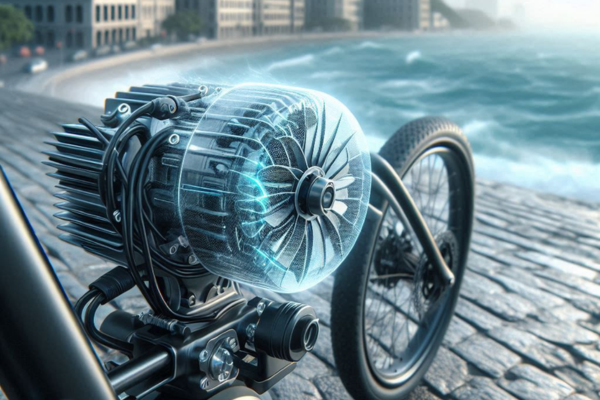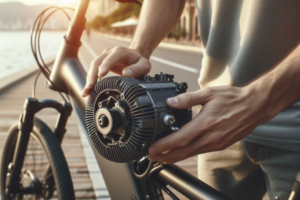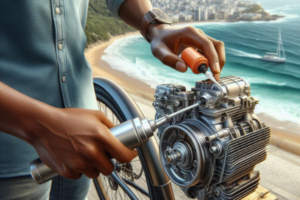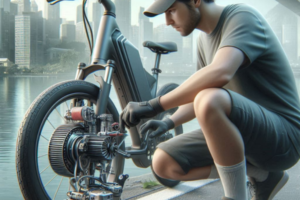🌊 Why Motor Protection Matters More Near the Coast
If the battery is the lifeblood of your electric bicycle, the motor is undoubtedly its heart. It powers your journey, determines your acceleration, and makes your ride effortless. But in coastal environments — where salty air, high humidity, and temperature shifts dominate — your motor faces constant invisible threats.
Unlike visible damage caused by accidents or heavy impact, salt-laden air and excess moisture creep in silently. They corrode connectors, infiltrate motor housings, and slowly degrade performance. Over time, this leads to reduced power output, inconsistent throttle response, and even complete motor failure.
Whether you’re a daily commuter cycling along a breezy coastline or a weekend explorer navigating salty trails, understanding how to protect your motor in a coastal climate is essential. Fortunately, modern tools, practices, and small upgrades can dramatically increase your motor’s lifespan and preserve your bike’s performance.
⚙️ How Coastal Conditions Impact Your E-Bike Motor
The salty, humid air near coastal regions creates an environment that is both beautiful and brutal — especially for sensitive mechanical and electrical components. Here’s what your motor is up against every day:
- 🧂 Salt corrosion: Even if you don’t ride into the ocean, salt particles in the air settle on your motor housing and connectors, leading to oxidation and power loss over time.
- 💦 Moisture penetration: Humid air causes condensation inside sealed motor units if ventilation is poor, creating rust in bearings and affecting internal magnets or wiring.
- ⚡ Connector degradation: The cables that carry power from the battery to the motor are vulnerable to micro-corrosion at the contact points, leading to inconsistent power delivery or short circuits.
- 🌡️ Thermal stress: Heat and humidity can increase internal temperatures in the motor, especially if ventilation or thermal regulation is insufficient.
These issues don’t occur overnight, but they often go unnoticed until performance dips or repairs are costly. The key is proactive care — knowing what to look for, what to install, and how to treat your bike’s motor as a critical, delicate machine.
💡 Reflection From the Shore
“The sea gives us fresh air and freedom — but also salt and time. To ride long, you must protect what moves you.”
In the next sections, we’ll explore specific solutions that riders like you can adopt to defend the heart of your electric bike. Whether you’re in Cartagena, Miami, Barcelona, or any other coastal gem, these practices will help keep your motor strong, silent, and safe from the sea.
🔧 Smart Technologies to Protect Your Motor in Coastal Environments
Riding near the ocean doesn’t mean accepting damage as inevitable. A wide range of technological solutions now exist to shield your motor from salt, moisture, and corrosion — ensuring that your e-bike remains reliable, efficient, and powerful in even the most humid climates.
🛡️ 1. IP-Rated Motor Enclosures
When buying or upgrading an electric bicycle for coastal use, look for motors with a minimum ingress protection (IP) rating of IP65 or higher. This rating ensures that the motor casing resists dust, splashes, and — more importantly — persistent humidity. Hub motors and mid-drive motors should both have seals and gaskets designed to repel fine salt particles that linger in the air.
⚡ 2. Corrosion-Resistant Connectors and Cables
Standard wiring may degrade quickly when exposed to coastal air. Upgrading to connectors with marine-grade coatings (such as gold-plated pins or silicone-sealed housings) can help reduce energy loss and signal interference. Look for waterproof quick-connect systems that make inspection easy while resisting corrosion buildup at key contact points.
🧯 3. Anti-Corrosion Spray Coatings
A protective coating applied to the motor shell and exposed hardware can form a barrier between the environment and the metal. Sprays like ACF-50 or dielectric protectants offer invisible, moisture-repelling protection. Reapplying these sprays every 2–3 months can drastically reduce the rate of corrosion on both internal and external parts.
🌡️ 4. Thermal Management Enhancements
Motors in warm coastal cities often experience thermal strain — which accelerates corrosion from the inside. Adding heat sinks or ensuring ventilation ducts around the motor casing are clear can reduce internal stress. Some aftermarket covers also include reflective material to deflect external heat while maintaining breathability.
📦 5. Smart Motor Controllers
Modern e-bike controllers can detect small anomalies in motor behavior, such as slight drops in torque or current fluctuations that indicate corrosion or signal failure. Brands like Bosch, Bafang, and Shimano now integrate software that alerts you early — before physical damage becomes visible. This is especially valuable in coastal settings where damage happens gradually.
📊 Comparison Table: Basic vs. Coastal-Ready Motor Systems
| Component | Standard Setup | Coastal-Optimized |
|---|---|---|
| Motor Enclosure | Standard IP54 shell | Sealed IP65+ water-resistant shell |
| Connectors | Exposed or basic plastic pins | Gold-plated waterproof connectors |
| Protective Coatings | None or basic paint | ACF-50 or dielectric barrier applied |
| Thermal Control | Passive heat dispersion | Ventilated covers and heat deflectors |
💬 Tech Wisdom
“The ocean teaches resilience — and so must your ride. Smart protection turns salty air into silent victories.”
Investing in these simple but powerful tools helps you stay ahead of the environment. And every ride becomes not just an act of movement — but of intention and care.
🌍 Real Story: Riding Strong on the Chilean Coast
Carlos lives in Valparaíso, Chile — a coastal city where the sea breeze is ever-present and the hills are steep. As a technician and part-time delivery rider, Carlos relies heavily on his electric bicycle to navigate urban climbs and reach clients efficiently. At first, his bike performed beautifully. But after five months, he noticed power fading during uphill rides and heard an unusual noise from the rear hub motor.
At a local repair shop, the mechanic opened the motor shell and found early-stage corrosion on the magnet coils and rust along the casing seams. The salty air had silently worked its way into the motor housing. No water had splashed in — it was the atmosphere alone. The technician cleaned and resealed the motor, and then offered a piece of advice that changed everything: “Start treating your bike like a boat.”
Carlos took that advice seriously. He began applying anti-corrosion spray monthly, sealed his connectors with marine-grade dielectric grease, and stored his bike indoors near a dehumidifier. Three months later, his motor was not only healthy — it felt stronger, smoother, and quieter than ever.
🔧 Small Habits That Protect Your Motor Daily
Motor damage doesn’t happen suddenly. It’s the result of accumulation — and it’s preventable with simple, consistent care. Here are daily and weekly habits every coastal rider should embrace:
- 🧽 Wipe the motor casing after every ride: Especially near the sea, salt residue sticks to surfaces even on sunny days. A microfiber cloth prevents build-up.
- 🔌 Inspect power connectors weekly: Look for discoloration, buildup, or looseness. If accessible, clean lightly with electrical contact spray.
- 🛢️ Apply corrosion inhibitor monthly: Use products like ACF-50, Boeshield T-9, or WD-40 Specialist to protect bolts, housings, and seams from oxidation.
- 🏠 Store the bike in a dry, ventilated space: Avoid plastic covers that trap humidity. Instead, use breathable fabric or keep near passive ventilation.
- 📱 Use diagnostic apps when available: Many e-bike systems (like Shimano E-Tube or Bosch Smart System) can detect inefficiencies in motor performance and alert you early.
These habits don’t require technical skill — just awareness and consistency. Riders who commit to them often avoid major motor repairs and preserve full performance year-round.
💡 Insight from Experience
“The sea tests everything it touches. But if you respect it — and prepare for it — your motor will carry you farther than you dreamed.”
Carlos’s story isn’t unusual. Around the world, riders in coastal cities are learning that motor protection is not about reacting — it’s about anticipating. With a few tools and a little love, your bike’s most vital part will keep beating strong through every salty breeze.
🚫 Common Mistakes That Weaken E-Bike Motors in Coastal Regions
Even riders with years of experience often overlook small but critical details when it comes to motor protection. Coastal conditions create specific risks that, if not addressed proactively, can lead to costly repairs and major efficiency loss.
Here are the most common mistakes — and how to avoid them:
- ❌ Storing bikes in sealed plastic covers: These covers trap humid air, accelerating corrosion inside motor compartments. Use breathable materials or ventilated storage instead.
- ❌ Spraying water directly onto the motor during cleaning: Even sealed motors can be vulnerable if pressure washing pushes moisture past the gaskets. Always wipe gently and avoid spraying near connectors.
- ❌ Delaying small repairs or ignoring unusual noises: Clicking, humming, or resistance may signal early-stage corrosion inside bearings or motor mounts. Addressing them early prevents full system breakdowns.
- ❌ Using dry lubes or basic household products: Only use lubricants and corrosion protectants designed for marine or high-humidity environments. Generic sprays often evaporate quickly and leave parts exposed.
- ❌ Failing to check motor firmware: Some performance issues aren’t mechanical — they’re digital. Ignoring updates can leave your motor running less efficiently than designed.
📋 Weekly Motor Care Checklist for Coastal Riders
Here’s a checklist to protect your motor from the sea’s subtle but persistent reach. Most of these actions take just a few minutes but can save you hundreds of dollars in the long run.
- ✅ Dry the motor casing and connectors after every ride.
- ✅ Inspect power cables and controller inputs weekly.
- ✅ Apply protective spray to bolts and casing once a month.
- ✅ Use a soft brush to remove sand or salt from motor vents.
- ✅ Store your bike in a dry, shaded area with airflow.
- ✅ Run a system diagnostic or firmware check every 1–2 months.
You can print this checklist and hang it near your bike or charger. Turning it into a habit ensures that your e-bike’s motor remains healthy, responsive, and ready — no matter the weather outside.
💬 A Reminder of Control
“The sea doesn’t ask for permission — but it does respect preparation. Motor care is how you ride through storms with peace of mind.”
In high-humidity environments, prevention is the most powerful form of protection. You don’t need to fear the ocean’s influence — you just need to understand how to ride alongside it, with respect and smart habits.
❓ Frequently Asked Questions (FAQs)
How often should I clean my motor if I live near the coast?
You should gently wipe the motor casing and connector areas after every ride. Monthly application of corrosion inhibitors is also recommended. If you ride daily or store your bike outdoors, consider bi-weekly inspections.
Can salt really damage the motor without direct water contact?
Yes. Salt is present in the coastal air, especially within a few kilometers of the shoreline. It settles on surfaces invisibly and reacts with metal components, leading to corrosion even without any visible water exposure.
Should I open my motor to check for rust?
Not unless you’re experienced. Most motors are sealed, and opening them can void warranties. Instead, monitor performance changes, noise, or vibrations. Use apps or diagnostics when available, and consult a technician annually if riding regularly in harsh climates.
Do hub motors or mid-drive motors handle coastal conditions better?
Both can perform well if properly protected. However, hub motors are fully sealed by design and may be slightly more resistant to salt intrusion. Regardless of motor type, maintenance and smart upgrades are far more important than design alone.
Is dielectric grease safe to use on e-bike connectors?
Yes. Dielectric grease helps seal out moisture and prevent oxidation on power connectors and sensor plugs. Apply a thin layer to pins — not inside housings — and reapply every 2–3 months for best results.
💬 Final Thoughts
The motor is more than just a machine — it’s the silent partner in your every ride. In coastal regions, it deserves a little extra love. Not because it’s weak, but because it works tirelessly in an environment where nature is both beautiful and demanding.
Protecting the heart of your electric bicycle doesn’t require expensive tools or complex repairs. It only takes awareness, intention, and a willingness to prepare. With each spray of anti-corrosion, each soft cloth wipe, each careful cable check — you’re not just maintaining a bike. You’re preserving freedom, efficiency, and peace of mind.
🌟 Join the Coastal Cycling Community
Do you ride along beaches, salt-sprayed roads, or coastal trails? Have you found tricks to protect your motor or learned from a tough experience? Your story matters — and it can inspire others to ride smarter and longer.
Leave your best tip, lesson, or question in the comments below. Together, we can build a stronger community of e-bike riders who ride with confidence — even by the sea.
Because when we care for what moves us, the road becomes endless.



